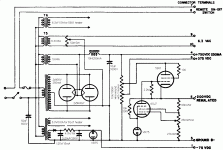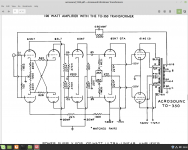Amp Design Ideas
Hi, so I have a couple of 6146s laying around, and I kind of want to build an amp with them, because according to their datasheet, they should be good for 70~80 watts in a Class AB1 pair. I've done some research, and there seem to be mixed opinions on them. Do they actually make decent audio tubes? The curves aren't very nice looking, so some feedback would absolutely be required. I was thinking that for the screen supply a pair of 0B3s would be good, as they should make about 180 volts in series.
For the OPT, I noticed that Edcor added some 100W transformers to their CXPP series, including one that's 6.6k P-P, which seems to be a good load for these tubes. Also, getting a 100 watt transformer should improve the amp's frequency response at higher wattages if I understand correctly.
For a power transformer, I was looking at a 400VA toroid from Antek, as I can get a 475V one for about 60 dollars before shipping. I would also need to obtain at least one choke. I think I'm going to use a SS rectifier, as the Antek Transformers don't have a 5 volt winding, and for an amp with this much current draw, it's easier I think.
Does any of this seem reasonable? Any immediate problems that would shut this project down?
Thanks, let me know your thoughts!
Hi, so I have a couple of 6146s laying around, and I kind of want to build an amp with them, because according to their datasheet, they should be good for 70~80 watts in a Class AB1 pair. I've done some research, and there seem to be mixed opinions on them. Do they actually make decent audio tubes? The curves aren't very nice looking, so some feedback would absolutely be required. I was thinking that for the screen supply a pair of 0B3s would be good, as they should make about 180 volts in series.
For the OPT, I noticed that Edcor added some 100W transformers to their CXPP series, including one that's 6.6k P-P, which seems to be a good load for these tubes. Also, getting a 100 watt transformer should improve the amp's frequency response at higher wattages if I understand correctly.
For a power transformer, I was looking at a 400VA toroid from Antek, as I can get a 475V one for about 60 dollars before shipping. I would also need to obtain at least one choke. I think I'm going to use a SS rectifier, as the Antek Transformers don't have a 5 volt winding, and for an amp with this much current draw, it's easier I think.
Does any of this seem reasonable? Any immediate problems that would shut this project down?
Thanks, let me know your thoughts!
Last edited:
I've actually listened to a 6146 PP build a fair amount at a friend's house locally. I haven't had it on my bench though.
Here's a complete design for a 6146 PP amp using 8K iron.
I would have less than stellar confidence regarding putting a lot of feedback around Edcor iron, but at the same time you're not going to find an 8K/100W transformer in Hammond's catalog. That leaves you with custom iron or searching for Peerless parts.
The lower voltage operating points that go with 4K and 5K iron in the RCA datasheet is probably an easier target. The Dynaco A431 iron is available from multiple vendors and might be a nice place to start. You could scale the attached design to just run off a 400V rail, use a zener in the negative rail (or no regulation at all), and tweak the screen regulator accordingly.
Here's a complete design for a 6146 PP amp using 8K iron.
I would have less than stellar confidence regarding putting a lot of feedback around Edcor iron, but at the same time you're not going to find an 8K/100W transformer in Hammond's catalog. That leaves you with custom iron or searching for Peerless parts.
The lower voltage operating points that go with 4K and 5K iron in the RCA datasheet is probably an easier target. The Dynaco A431 iron is available from multiple vendors and might be a nice place to start. You could scale the attached design to just run off a 400V rail, use a zener in the negative rail (or no regulation at all), and tweak the screen regulator accordingly.
Attachments
Some more schematics:
Attachments
-
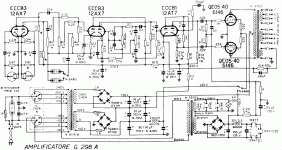 2 x ECC83 + ECC81 + 2 x 6146 pp (Geloso G298A).gif96.3 KB · Views: 1,074
2 x ECC83 + ECC81 + 2 x 6146 pp (Geloso G298A).gif96.3 KB · Views: 1,074 -
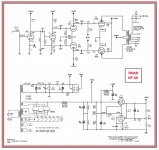 4 x 6S4 + 2 x 6146 pp + 2 x 5R4GY + 6L6G + 6SJ7 + 2 x 0A3 (Triad HF-40).jpg560.8 KB · Views: 1,170
4 x 6S4 + 2 x 6146 pp + 2 x 5R4GY + 6L6G + 6SJ7 + 2 x 0A3 (Triad HF-40).jpg560.8 KB · Views: 1,170 -
6AU6 + 6S4 + 2 x 6146 pp + 5R4 + 12BH7 + 0B2 (Leasebreaker).pdf1.2 MB · Views: 322
-
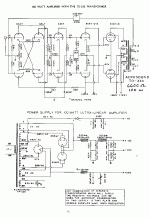 6SN7 dc-coupled + 6SL7 + 6SN7 + 6SN7GTA dc-coupled c-follower + 2 x 6146 ul pp + 2 x 5R4GY + 5Y3.gif23.2 KB · Views: 1,411
6SN7 dc-coupled + 6SL7 + 6SN7 + 6SN7GTA dc-coupled c-follower + 2 x 6146 ul pp + 2 x 5R4GY + 5Y3.gif23.2 KB · Views: 1,411 -
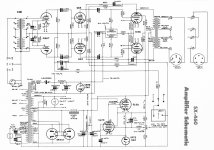 Transformer-coupled 12AU7 + 2 x 6S4 + 2 x 6146 pp + 2 x 5R4GY + 6L6G + 5879 + 2 x VR75 (Ballenty.jpg509.7 KB · Views: 1,991
Transformer-coupled 12AU7 + 2 x 6S4 + 2 x 6146 pp + 2 x 5R4GY + 6L6G + 5879 + 2 x VR75 (Ballenty.jpg509.7 KB · Views: 1,991
I have uses 30db of feedback with Edcor OPT before, it just requires some compensation like any other OPT.
They are relatively similar to a 2E26. I'm not entirely sure about the 6146, but a lot of tubes designed for RF service work much better in AB2.
A 100W 8K Edcor transformer may be a challenge when it comes to large amounts of feedback. I built an amp around a pair of 6.6K 50W transformers, and I was able to get about 16 or 17 dB of feedback. The larger transformers with higher primary impedances tend to be significantly worse.
My suggestion would be to sell the 6146s and buy some 6L6s. Good 6146s fetch reasonable money since they are still such a nice RF tube. They really aren't great for audio usage. Lots of hams are still running Kenwood hybrid rigs that use 6146s in the final section, so there is decent demand for them.
If you do go forward with the project, be very careful of parasitic oscillations, potentially up into the VHF range. This tube was designed from the ground up for RF service. Grid stoppers, screen stoppers, and even parasitic traps close to the plate cap are a good idea.
A 100W 8K Edcor transformer may be a challenge when it comes to large amounts of feedback. I built an amp around a pair of 6.6K 50W transformers, and I was able to get about 16 or 17 dB of feedback. The larger transformers with higher primary impedances tend to be significantly worse.
My suggestion would be to sell the 6146s and buy some 6L6s. Good 6146s fetch reasonable money since they are still such a nice RF tube. They really aren't great for audio usage. Lots of hams are still running Kenwood hybrid rigs that use 6146s in the final section, so there is decent demand for them.
If you do go forward with the project, be very careful of parasitic oscillations, potentially up into the VHF range. This tube was designed from the ground up for RF service. Grid stoppers, screen stoppers, and even parasitic traps close to the plate cap are a good idea.
Hmm, reading over this it does seem like it might be wise to do something easier and cheaper, as I don't have a ton of experience. As someone suggested, I'll probably flip these on eBay and pick up some better audio tubes.
Thanks!
Thanks!
Internally and electrically 6146 is very similar to 807, the main difference between 6146 and 807 is the size of the glass bottle, I have seen some text about that 6146 should have shorter life due to easier overheating because of the smaller glass bottle but I don't know if its true.
The first tube amp I built when I was 15, (50 years ago!) used 807's in penthode coupling, the tubes came from some old navy transmitter, when the tubes run out I switched to 6146B tubes, I didn't need to change anything when switching to the 6146B and I used the amp many years like that.
The first tube amp I built when I was 15, (50 years ago!) used 807's in penthode coupling, the tubes came from some old navy transmitter, when the tubes run out I switched to 6146B tubes, I didn't need to change anything when switching to the 6146B and I used the amp many years like that.
As a rule, I don't necessarily like shoehorning tubes into audio amps if they aren't designed for it. Some tubes, like the 845 and 211, seem to work really pretty well (audio is about the only thing the 845 is good for).
Vacuum tubes have been used for an incredible array of applications ranging from buffering the capsule on a condenser microphone to operating as a 20 kV 100A switch. That's without even getting into klystrons and TWTs.
The type 527 is a directly heated triode with a 300W plate dissipation. Sounds like a great SET tube, right? Actually, it requires 135A @ 5.5V just to light the filament. It was designed for use in radar pulsers, capable of a peak emission of 100A and able to hold off 20 kV. Not something you really want in your living room. There were a lot of incredible tubes like the 527 designed primarily for use in radar systems during WWII, and most of them aren't really much good for audio usage.
Vacuum tubes have been used for an incredible array of applications ranging from buffering the capsule on a condenser microphone to operating as a 20 kV 100A switch. That's without even getting into klystrons and TWTs.
The type 527 is a directly heated triode with a 300W plate dissipation. Sounds like a great SET tube, right? Actually, it requires 135A @ 5.5V just to light the filament. It was designed for use in radar pulsers, capable of a peak emission of 100A and able to hold off 20 kV. Not something you really want in your living room. There were a lot of incredible tubes like the 527 designed primarily for use in radar systems during WWII, and most of them aren't really much good for audio usage.
Internally and electrically 6146 is very similar to 807, the main difference between 6146 and 807 is the size of the glass bottle
The 6146 is a completely different animal. An 807 is essentially a 6L6G with a 5 pin base and a plate cap. A 6146 has different internals and different characteristics.
People run EL34s in an amp designed for 6L6s and vice versa. That does not mean they are very similar.
Last edited:
Part of the reason I was looking at these tubes is that I had them already, but also because 2 more weren't that bad. I've been looking at something like 6550s, and pairs are like 70 dollars. I can spend that, but I figured I would use something else before buying more tubes. I guess there's a reason they're so expensive. 100 watts at 2.5% THD looks really nice!
I don't think the 6146 is a bad tube for audio, as RCA certainty pushed that aspect. The issue was, I believe, that UL was becoming very common, and the 6146 isn't suitable for UL as it requires a relatively low screen grid voltage. If you can provide a good, regulated, screen grid supply you could have a good amp with 6146s. Note that the 6146B is enough different from the 6146 and 6146A that you shouldn't mix them in the same PP amp.
Part of the reason I was looking at these tubes is that I had them already, but also because 2 more weren't that bad. I've been looking at something like 6550s, and pairs are like 70 dollars. I can spend that, but I figured I would use something else before buying more tubes. I guess there's a reason they're so expensive. 100 watts at 2.5% THD looks really nice!
6550s are expensive because they are in demand for audio amplifiers. New production ones are costly because it's a bigger tube, and NOS fetch high prices because some people believe they are better.
First I would suggest figuring out how much power you really need. This is mostly an issue of room size and speaker efficiency. Big tube amps are very expensive and don't necessarily sound as good as some of the smaller ones. Making big output transformers perform well is difficult, and there are fewer options on the market.
Nothing is stopping you from building an 80-100W tube amp, but be warned that it may not sound as beautiful as some of the smaller amps based around 6L6s or EL34s.
The other amp I've built is a 6V6 triode PP amp, and while it sounds good, I'm not sure my speaker is really efficient as it needs to be. It sounds really good, but only produces ~6 Watts, which isn't really enough. Would I be better off with something like 6L6 Push Pull? I'm also open to building a stereo amplifier, even if the power supply design is more complicated. I was looking on eBay, and saw a listing that claimed they were 6N3Cs, which were like 6L6s for very cheap for a matched pair. Would that be better?
A push-pull 6L6 should make 30 watts without issue, possibly more if you push it. There are a whole host of 6L6-oids that will all perform well here. The 807, 1625, 6BG6, 5881, 7581, 6L6, 6L6G, 6L6GB, 6L6GC, and several different Soviet tubes are all electrically quite similar. Some have higher plate dissipation ratings and some have limited screen voltage ratings, however. For example, it isn't recommended to run the original 6L6 in ultralinear operation. The Russian tubes are perfectly good, but I can never remember which ones are which. You'll have to dig through some datasheets to see what the rated specs are.
Another good tube to consider is the EL34. The EL34 has a beefier cathode (hence the 1.5A filament rating). As a result, the primary impedance of the output transformer can be lower. The clones of the Dynaco A470 output transformers are ideal for EL34s and will be far superior to any of the Edcor transformers.
Another good tube to consider is the EL34. The EL34 has a beefier cathode (hence the 1.5A filament rating). As a result, the primary impedance of the output transformer can be lower. The clones of the Dynaco A470 output transformers are ideal for EL34s and will be far superior to any of the Edcor transformers.
Ooh yea, I was looking at EL34 pairs, and 45ish USD for a pair of JJ EL34s seems to be a good deal. I'll look at different output transformers, but the reason I was looking at the Edcors was that the price was good. I'm just a teenager without a job, so I don't have more than a couple hundred USD to spend on a project. I'll do some more research!
The infamous Ampeg SVT 300 Watt stage amp was first built with 6146es (3 pair). Within a couple years it was redesigned on selected 6550. I don't know the backstory, but selected 6550 were not cheaper than 6146 in those days. I have always *thought* that the 6146 would take the abuse in a lab for a week, but not on stage for a month reliably. (Also there low-grade 6146 then, while the 6550 was limited-source.)
And you also wonder why the 6550 was developed if the older 6146 was completely satisfactory.
I'm sure a good amp can be built on 6146. And even make 100W/pair in home duty. But there may be easier ways.
And you also wonder why the 6550 was developed if the older 6146 was completely satisfactory.
I'm sure a good amp can be built on 6146. And even make 100W/pair in home duty. But there may be easier ways.
I guess that makes sense! I actually have an Ampeg SVT (6550 Version) that will be a future project (It's pretty neglected). I think the 6146s are probably out of both my skillset and budget at the moment though. Transformers are seriously pricey for that much power.
Attachments
I was looking on eBay, and saw a listing that claimed they were 6N3Cs, which were like 6L6s for very cheap for a matched pair. Would that be better?
The Russian 6Π3C-E (6p3s-e) is nice 5881 equivalent. The tube New Sensor sells under the Sovtek label as a 5881 is 6Π3C-E. Personally, I would not touch stuff without the "E" suffix.
The Acrosound circuit uses an OPT with a tertiary winding for the screens, and I think that Edcor OPT is just a standard UL OPT.
It would be great if there were transformers available with a seperate screen winding! I asked Toroidy if they could wind one, but they said it was not possible on the core, insufficient room. There is a Van der Veen option, apparently, but that is not feasible from a financial POV.
- Home
- Amplifiers
- Tubes / Valves
- 6146 Amp Feasibility
